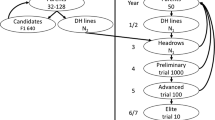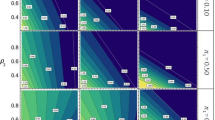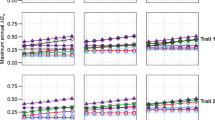Abstract
Truncation selection is often used to rapidly achieve short-term genetic gain within a breeding program. Unfortunately, it is also associated with the loss of favorable QTL alleles in the breeding population, causing a premature convergence to sub-optimal genetic values. Parental selection strategies such as the scoping method, the population merit method, and optimal cross selection have been proposed to preserve genetic variation in the breeding population and thus maximize genetic gain in the long term. Nevertheless, for economic reasons, breeders are often interested to maximize the genetic gain in a shorter time frame. We propose a new selection strategy, named the adaptive scoping method, that aims at maximizing the genetic gain within a specific, predefined time frame. Throughout this time frame, the adaptive scoping method progressively changes its selection strategy: during the initial breeding cycles, it attempts to maximally preserve genetic variation, whereas in later breeding cycles, it prioritizes the increase of the genetic value. We demonstrate through simulation studies that the adaptive scoping method is able to maximize the genetic gain for a wide range of time frames and that it outperforms the original scoping method, both in the short and in the long term.







Similar content being viewed by others
References
Akdemir D, Sánchez JI (2016) Efficient breeding by genomic mating. Front Genet 7:1–12
Allier A, Teyssèdre S, Lehermeier C, Charcosset A, Moreau L (2020) Genomic prediction with a maize collaborative panel: identification of genetic resources to enrich elite breeding programs. Theor Appl Genet 133(1):201–215
Allier A, Teyssèdre S, Lehermeier C, Moreau L, Charcosset A (2020) Optimized breeding strategies to harness genetic resources with different performance levels. BMC Genet 21(1):1–16
Bernardo R (2014) Genomewide selection of parental inbreds: Classes of loci and virtual biparental populations. Crop Sci 54(6):2586–2595
Brisbane JR, Gibson JP (1995) Balancing selection response and inbreeding by including predicted stabilised genetic contributions in selection decisions. Genet Sel Evol 27(6):541–549
Cervantes I, Gutiérrez JP, Meuwissen THE (2016) Response to selection while maximizing genetic variance in small populations. Genet Sel Evol 48(1):1–9
Chang LY, Toghiani S, Ling A, Aggrey SE, Rekaya R (2018) High density marker panels, SNPs prioritizing and accuracy of genomic selection. BMC Genet 19(1):1–10
Clark SA, Hickey JM, Van Der Werf JHJ (2011) Different models of genetic variation and their effect on genomic evaluation. Genet Sel Evol 43(1):1–9
Endelman JB (2011) Ridge regression and other kernels for genomic selection with R package rrBLUP. Plant Genome 4(3):250–255
Gorjanc G, Gaynor RC, Hickey JM (2018) Optimal cross selection for long-term genetic gain in two-part programs with rapid recurrent genomic selection. Theor Appl Genet 131(9):1953–1966
Jannink JL (2010) Dynamics of long-term genomic selection. Genet Sel Evol 42(1):1–11
Lindgren D, Mullin TJ (1997) Balancing gain and relatedness in selection. Silvae Genet 3(2):124–129
Meuwissen THE (1997) Maximizing the respond of selection with a predifined rate of inbreeding. J Anim Sci 75:934–940
Meuwissen THE, Hayes BJ, Goddard ME (2001) Prediction of total genetic value using genome-wide dense marker maps. Genetics 157:1819–1829
Neyhart JL, Tiede T, Lorenz AJ, Smith KP (2017) Evaluating methods of updating training data in long-term genomewide selection. G3 7(5):1499–1510
Piepho HP, Möhring J, Melchinger AE, Büchse A (2008) BLUP for phenotypic selection in plant breeding and variety testing. Euphytica 161(1):209–228
Pszczola M, Strabel T, Mulder HA, Calus MPL (2012) Reliability of direct genomic values for animals with different relationships within and to the reference population. J Dairy Sci 95(1):389–400
Sonesson AK, Woolliams JA, Meuwissen THE (2012) Genomic selection requires genomic control of inbreeding. Genet Sel Evol 44(27):1–10
Vanavermaete D, Fostier J, Maenhout S, De Baets B (2020) Preservation of genetic variation in a breeding population for long-term genetic gain. G3 10(8):2753–2762
VanRaden PM (2008) Efficient methods to compute genomic predictions. J Dairy Sci 91(11):4414–4423
Woolliams JA, Berg P, Dagnachew BS, Meuwissen THE (2015) Genetic contributions and their optimization. J Anim Breed Genet 132(2):89–99
Wray NR, Goddard ME (1994) Increasing long-term response to selection. Genet Sel Evol 26:431–451
Wray NR, Thompson R (1990) Prediction of rates of inbreeding in selected populations. Genet Res 55:41–54
Funding
Funding was provided by Ghent University.
Author information
Authors and Affiliations
Contributions
DV, JF, SM, and BDB conceived and supervised the study. DV designed and performed the experiments, and wrote an early version of the manuscript. All authors reviewed and approved the manuscript.
Corresponding author
Ethics declarations
Conflict of interest
The authors declare that they have no conflict of interest.
Additional information
Publisher's Note
Springer Nature remains neutral with regard to jurisdictional claims in published maps and institutional affiliations.
Rights and permissions
About this article
Cite this article
Vanavermaete, D., Fostier, J., Maenhout, S. et al. Adaptive scoping: balancing short- and long-term genetic gain in plant breeding. Euphytica 218, 109 (2022). https://doi.org/10.1007/s10681-022-03065-1
Received:
Accepted:
Published:
DOI: https://doi.org/10.1007/s10681-022-03065-1




